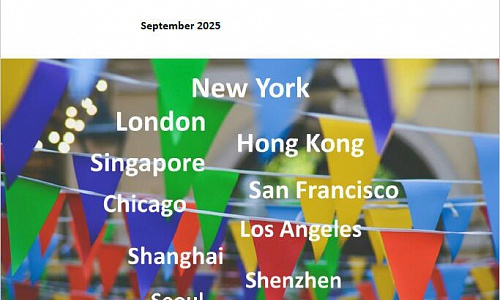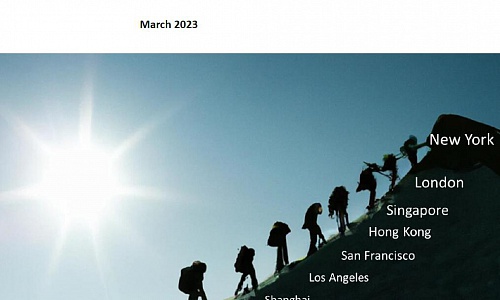Information
 Dr. Sean Randolph, senior director of Bay Area Council Economic Institute, analyzed the particular relevance of both San Francisco Bay Area and Silicon Valley for the future development of Guangdong-Hong Kong-Macao Great Bay Area and Shenzhen.
Dr. Sean Randolph, senior director of Bay Area Council Economic Institute, analyzed the particular relevance of both San Francisco Bay Area and Silicon Valley for the future development of Guangdong-Hong Kong-Macao Great Bay Area and Shenzhen.
Hosted by: CDI
Theme: Building a Global Innovation Center: Experience of San Francisco Bay Area and Silicon Valley
Programme
15:00-15:05 Opening Remarks
GUO Wanda, Executive Vice President, CDI
Moderator: LI Jinkui, Senior Research Fellow, CDI
15:05-16:05 Report on Building a Global Innovation Center: Experience of San Francisco Bay Area and Silicon Valley
Speaker: Sean RANDOLPH, Senior Director, Bay Area Council Economic Institute
16:05-16:55 Q&A
16:55-17:00 Closing Remarks
Highlights
The Silicon Valley Model for Innovation-based Bay Area
With Silicon Valley located in the southern part, the San Francisco Bay Area has become a renowned R&D center in the world. The key to San Francisco Bay Area’s success is that it has managed to build a complete innovation system with free mobility of talent and ideas. This meeting has summarized the valuable experience of the San Francisco Bay Area in building a global innovation center in the following five aspects.
Sound ecosystem as foundation for innovation centers
In the process of building a global innovation center, a sound eco-system comprising multiple institutions and diverse talents plays a vital role. The inter-connectivity between various factors within the system results in the highly diverse organizational form of the bay area.
The San Francisco Bay Area boasts abundant research universities and laboratories, including five research universities namely, Stanford, University of California Berkeley, UC San Francisco, UC Davis, UC Santa Cruz, and 25 national or state laboratories. In addition, the San Francisco Bay Area is home to a number of collaborative research models, including Sandia Open Campus, Joint Bio-Energy Institute (JBEI) and California Centers for Science & Innovation. These open platforms have attracted many companies as partners for joint research and shared access to capabilities, which produces fruitful results and promotes the utilization of innovation resources.
The San Francisco Bay Area possesses unique corporate laboratories. Regionally headquartered companies have set up their laboratories, which mainly focus on product research, while also paying attention to technological innovation and its application on products. These laboratories do research on the prospect of their respective industries and how information and digital technologies are going to revolutionize all industries.
Different types of incubators and accelerators can be found in the San Francisco Bay Area, which can either be independent or sponsored by universities, corporations or local governments. For universities, sponsoring start-ups will indirectly impact the local economic development on one hand, and boost their own strength in evaluating indicators on the other. For governments, sponsoring start-ups to develop in Silicon Valley will bring about considerable social economic benefits. Corporations hope the start-ups they sponsor can in turn help themselves develop better in future.
This eco-system includes different kinds of public and private entities, incubators and accelerators, and therefore acts as a huge network which facilitates free mobility of innovation resources.
Collaborative network as key for innovation centers
More R&D is now being generated through global collaboration. In the San Francisco Bay Area, different institutions and stakeholders collaborate with each other instead of operating alone. At the same time, a bay area is an innovation hub closely connected with other important innovation centers of the world. The collaborative network makes the whole innovation system work more efficiently.
The workforce of the San Francisco Bay Area has a global background. Most talents come from countries other than the United States. Professionals from the whole world gather in the San Francisco Bay Area, creating innovative products in the collaborative network forged by universities, research institutions, governments and corporations. The products and services of the Bay Area are therefore the fruits of global collaboration.
The San Francisco Bay Area features strong mobility and flexibility. People working there earn credit for their skills or innovative ideas and enjoy good opportunities for personal development regardless of where they come from. This also helps achieve a fluid flow of people, information and ideas across institutional and organizational boundaries. There exist, however, red tape in visa application process and barriers to the communication of ideas. Only by eliminating or reducing such hindrances can an even freer movement of people and ideas be achieved.
Shared corporate values as driver for innovation centers
In Silicon Valley, corporations or founders have a considerably high acceptance of risk. Close to 50% of US venture investment is in the Bay Area. Emerging industries’ need for capital, corporate partnership, incubators or accelerators can be easily met in the Bay Area. All venture capital shows a growing trend.
Thus, the overall corporate culture in the whole San Francisco Bay Area or Silicon Valley features readiness to learn and improve. As to the high risks of failure confronted by start-ups, the solution shall be to build leadership, attract professionals and keep trying until success. The San Francisco Bay Area as a whole or Silicon Valley in particular are highly tolerant of failure. The acceptance of risk and failure is a shared culture among corporations in the Bay Area.
Cultural diversity and good urban environment as guarantee for attracting talents
Diversity of culture is one important factor in attracting talents. The San Francisco Bay Area is a place where the world’s talented young workers gather. In Silicon Valley, 52% of company founders are immigrants from different corners of the world. Cultural amenities are highly appealing to young talents, which the whole bay area of San Francisco possesses. The integration of cultures in San Francisco provides young people with more opportunities to enjoy cultural diversity.
Good urban planning also contributes to raising quality of life. In the Bay Area, there are many protected open spaces and green spaces. For young technical professionals, clean air and water, a comfortable living environment, efficient urban mobility are all essential, which have also become an important guarantee for the Bay Area to attract global technical professionals.
In sum, it is not only the business or employment opportunities within the Bay Area that attract well educated young people from around the world, but also the highly quality of life.
Assets and potential as stimulus for regional development
Different regions and cities are endowed with different assets and potential. There is no single development model for global innovation centers. Silicon Valley and the whole Bay Area are not planned but grows naturally, the development model of which is more about the integration of people, information and ideas. The successful experience of the San Francisco Bay Area in building a global innovation center is to be learned from but not necessarily copied. For example, compared with Silicon Valley, Shenzhen has strong global competitiveness with complete supply chains, a sound basis for manufacturing, abundant raw materials and a cultural atmosphere of innovation. These are the assets and potential unique to Shenzhen. Shenzhen shall find a way to achieve full mobility of people, information, ideas and production factors, effectively connecting them as well.
For the San Francisco Bay Area, open models are the most successful in building global innovation centers and the free movement of people, information and ideas in the whole collaborative network are crucial. Attractive environment is another factor contributing to the building of a global innovation center in San Francisco, which also guarantees its appeal for first-class talents of the world. Every region and city in the world shall set store by the unique assets they possess instead of blindly copying existing success stories.










